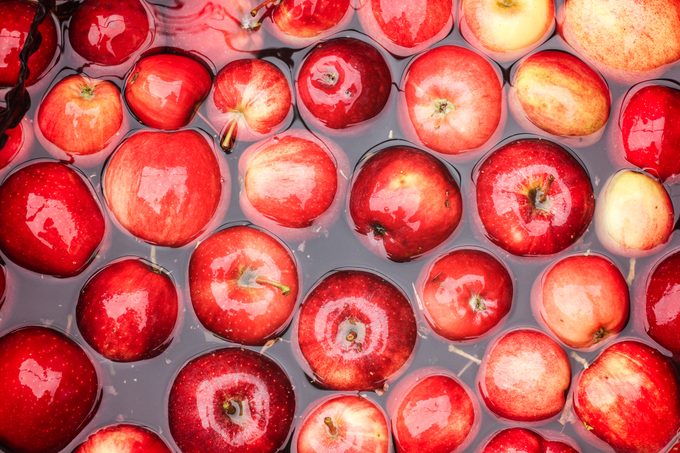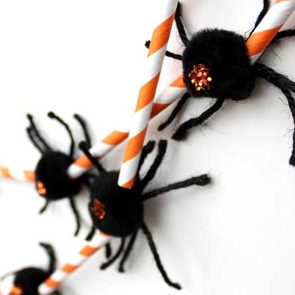Compared to other Halloween traditions and legends, bobbing for apples has less spooky origins

Why Do We Bob for Apples on Halloween?

You’ve probably heard of bobbing for apples, the classic Halloween game where people try to take a bite out of an apple floating in water. The image of multiple apples floating in a container full of water might bring up memories from your childhood, but did you know that, just like the traditions of carving jack-o’-lanterns and wearing Halloween colors, this tradition has deep roots in history?
If you’re curious to learn more about this Halloween tradition, keep scrolling because we’re letting you know about apple bobbing’s origins, its connection with Halloween and whether it’s really a safe game for you and the kids to do.
So read on to learn the fascinating history of bobbing for apples—it even includes an element of romance.
Get Reader’s Digest’s Read Up newsletter for more knowledge, fun facts, humor, cleaning, travel and tech all week long.
What is bobbing for apples?
Bobbing for apples is a game that can be played year-round, but it’s primarily played around autumn and Halloween. Here’s how to play:
- Fill a large bucket or basin with water
- Put apples in the water (since apples are less dense than water, they’ll float at the top)
- Have players try to get as many apples as possible only using their teeth—no hands!
Where did bobbing for apples come from?
Bobbing for apples started in Europe hundreds of years ago as a common way for young lovers to court one another. While there were many versions of the game, each apple represented a special someone. If the bobber, typically female, successfully bit into the apple with the name of a love interest in one go, then fortune favored the lucky couple and fate gave them the go-ahead. If it took the bobber two attempts, then they could still try it out but their love wouldn’t last a long time. Sadly, if the bobber needed three attempts to bite into the apple, then the stars weren’t aligned for this couple and it would probably be best to not pursue it at all.
Of course, as history progresses so, too, do the traditions. Another variation of bobbing for apples is the first person to bite an apple would be the next one in the group to have a marriage. If a girl bit into an apple and placed the fruit beneath her pillow, another superstition claims, she would see her true love in a dream.
Why do we bob for apples on Halloween?

To understand modern Halloween traditions like bobbing for apples, you have to understand Halloween history. The Celtic holiday Samhain (pronounced “sow-win”) is normally celebrated from October 31 to November 1 to signify the end of summer and welcome in the new fall harvest and “the dark half of the year.” The Romans and then the Christian Church took Samhain and adapted it, eventually trying to imagine Samhain as a Christian holiday. In short, Pope Gregory in the 9th century declared November 1 as All Saints’ Day and November 2 as All Souls’ Day. Traditional pagan practices can still be seen on modern-day Halloween, or All Hallows Eve, on October 31.
European and Irish immigrants brought their traditions to the Americas, including pagan traditions and other traditions, like bobbing for apples. Likewise, bobbing for apples became more well-known as some Americans researched their roots and wanted to use this Celtic tradition for Halloween.
Is bobbing for apples safe?
Bobbing for apples is a fun Halloween party game that people enjoy, but it’s important to keep safety in mind if when participating. The biggest thing to remember is that you aren’t the only one bobbing for apples. Other people are trying to snatch an apple with their teeth and, as such, germs can get into the water. If you or your kids aren’t feeling well, stay home and avoid bobbing for apples this year.
If you’re hosting a Halloween party and are planning to bob for apples, make sure you wash the apples thoroughly. The Food and Drug Administration (FDA) recommends washing apples in cool running water and using a produce brush to remove excess dirt. This will help reduce the number of bacteria that may be on the skin.
Additional reporting by Kelly Kuehn
Why trust us
At Reader’s Digest, we’re committed to producing high-quality content by writers with expertise and experience in their field in consultation with relevant, qualified experts. We rely on reputable primary sources, including government and professional organizations and academic institutions as well as our writers’ personal experiences where appropriate. We verify all facts and data, back them with credible sourcing and revisit them over time to ensure they remain accurate and up to date. Read more about our team, our contributors and our editorial policies.
Sources:
- History: “What is bobbing for apples?”
- History: “Samhain”
- U.S. Food and Drug Administration: “Halloween Food Safety Tips for Parents”






















